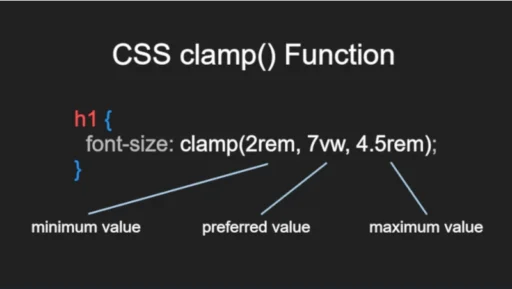The CSS clamp() function clamps a value between an upper and lower bound. It enables selecting a middle value within a range of values between a defined minimum and maximum. So it takes three parameters: a minimum value, a preferred value, and a maximum allowed value. 1

What is the difference between the CSS clamp function and the CSS viewport width unit? First, they are the same at some points if you resize the window. But they are slightly different in some screen sizes. See the example below.
CSS clamp() Function Example
Take a look at this CSS code example with two h1 tag selectors and font-size property:
h1.first {
font-size: clamp(2rem, 7vw, 4.5rem);
}
h1.second {
font-size: 7vw;
}The one with the clamp() function has a minimum and maximum value. When you resize the window, the font size will not be less than 2rem and more than 4.5rem.
The second selector font size with the viewport width unit will be smaller and larger as long as you resize the window without any limitations. See the below CodePen:
See the Pen CSS clamp() Function for Better Responsiveness by Alvand WP (@alvandwp) on CodePen.
Above, click on the EDIT ON CodePen at the top right corner. Then when opened, change the view to the right or left column from the top right. Now, resize the window to the lowest and highest possible amount.
CSS clamp() function prevents the headline font size from being too big on extra large screens and too small on extra small screens.
Conclusion
You can use this function with some other CSS properties like width. Think about how to use it in different situations. It will open some doors when coding your website.
Click on this link to see How to Adjust Website Width Using Browser Developer Tools or on this one if you want to know How to Have Splide Multiple Sliders on One Page.
References:

دیدگاهتان را بنویسید